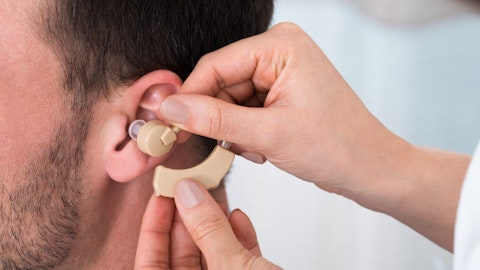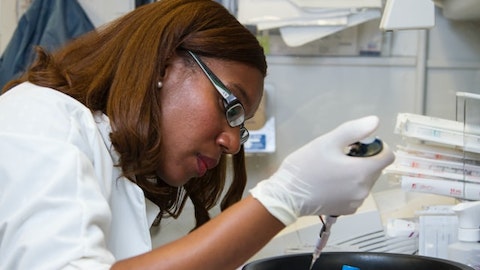ICU Medical, Inc. (NASDAQ:ICUI) Q3 2023 Earnings Call Transcript November 6, 2023
ICU Medical, Inc. beats earnings expectations. Reported EPS is $1.57, expectations were $1.29.
Operator: Good afternoon. And welcome to the ICU Medical Inc. Third Quarter 2023 Earnings Conference Call [Operator Instructions]. Please note, this event is being recorded. I would like now to turn the conference over to John Mills, Managing Partner at ICR. Please go ahead.
John Mills: Good afternoon, everyone. Thank you for joining us to discuss ICU medical’s financial results for the third quarter of 2023. On the call today representing ICU Medical is Vivek Jain, Chief Executive Officer and Chairman; and Brian Bonnell, Chief Financial Officer. We want to let everyone know that we have a presentation accompanying today’s prepared remarks. To view the presentation, please go to our Investor page and click on the Event calendar and it will be under the third quarter 2023 events. Before we start our prepared remarks, I want to touch upon any forward-looking statements made during the call, including beliefs and expectations about the company’s future results. Please be aware they are based on the best available information to management and assumptions that are reasonable.
Such statements are not intended to be a representation of future results and are subject to risks and uncertainties. Future results may differ materially from management’s current expectations. We refer all of you to the company’s SEC filings for more detailed information on the risks and uncertainties that have a direct bearing on the operating results and financial position. Please note that during the call today, we will also be discussing non-GAAP financial measures, including results on an adjusted basis. We believe these financial measures can facilitate a more complete analysis and greater transparency into ICU Medical’s ongoing results of operations, particularly when comparing underlying results from period-to-period. We also include a reconciliation of these non-GAAP measures in today’s release and provide as much detail as possible on any addendums that are added back.
And with that, it is my pleasure to turn the call over to Vivek.
Vivek Jain: Thanks, John. Good afternoon, everyone. We hope you’re well. Even with the volatility in the economic environment and some revenue variance in a few of our product lines, ICU Medical is operating very well for our customers in 2023, delivering high service levels, improving quality and relevant innovation. We’re also equally focused on ensuring we take the right short and long term steps to do the same for our other stakeholders. The global demand environment was generally consistent and healthy in Q3 and it continues to feel that way, and the only macro items were some uptick in fuel pricing and continued pressure from currencies in our production geographies. Like everyone in our industry, we want to start first by thanking our customers and the frontline workers for trusting us to serve you during these times.
We’ll use the time today to; discuss the Q3 revenue performance of our business units and hopefully, we’ve reached the point where this is the last quarter with unusual year-over-year comparisons; provide more color on some of the product families that have been good and some that have been challenged; go into a bit more detail on the actions we’ve been taking in aligning our inventory with demand, its impact on the P&L and explain why we’re making this temporary choice; update our next steps towards integration and synergy capture as there are no other meaningful housekeeping updates; check our progress against key short term priorities we outlined to start the year and quickly frame up some of the items on the strategic agenda and make clear where we want to be.
We finished the quarter with $547 million in adjusted revenues, adjusted EBITDA came in at $90 million and adjusted EPS was $1.57. Revenue growth was minus 6% on a constant currency and reported basis with growth in the legacy ICU portfolio, offset by year-over-year declines on the acquired products from Smith’s Group. We finally had a sequential decrease in inventories. And as we had previously described, our efforts to adjust output to bring inventory more in line with historical levels and as a result did generate some cash flow from operations and expect this trend to continue. The Mexican and Costa Rican local currencies continue to pressure gross margins in addition to the inventory correction. Our results reflected what we stated in the last call, good revenue growth in our differentiated historical portfolio and stability on the acquired product lines.
But the large catch up in fulfillments we started to make in Q3 of last year make the year-over-year results unattractive, so we’ll have to go into that in more detail. For the balance of the year, we would expect continued sequential revenue growth, improved cash flow from operations and to have earnings inside of our revised guidance from last quarter, but towards the lower end as we’ve prioritized inventory reduction. So let me start with our consumables business, which is our largest and most profitable business unit. We had $242 million in revenue, which was down 5% on a constant currency basis and down 4% reported. Again, we need to explain a bit more here. The legacy ICU product lines, IV therapy and oncology, which are the largest components of the business unit, had a record quarter again in Q3 with 7% growth, and those businesses combined to be the largest they’ve ever been.
That growth was driven by new customer implementations, consistent census throughout the quarter and increased capacity and ability to serve the market with a focus on clinical differentiation and the creation of niche markets. The tracheostomy unit was also slightly positive for the quarter. The balance was the same story as the first half of the year with large year-over-year negatives in Vascular Access, which were accentuated by the strong back order recovery and COVID syringe deliveries we had in this line in Q3 of 2022. Of course, that’s not desirable but we’ve been focused on stability here, and we have had stability sequentially for a few quarters now. On the last two calls, we said we’re at the bottom here as the losses occurred throughout last year and that it felt very similar to the IV consumables and pump losses when we purchased Hospira, when customer losses were still felt in the four to six quarters post deal.
In Q3, we did see some sequential improvement in the US Vascular Access lines, which is the largest portion of the product line, and that was offset by some minor variations OUS. But again, we did not backtrack versus the previous few quarters. For the year, nothing different than we said in the last call, we’re relative to our own expectations. Our best estimate is that we’ll be $20 million to $25 million short here for the year relative to our plan. And to be clear, our confidence and right to win here has not changed but it’s just taken time. The losses from 2021 and 2022 were predominantly due to supply issues and those have been addressed by our team as evidenced by our inventory overbuild. To be even more transparent, our medium and longer term expectations are only to get back the minority of what was lost over the last two years.
We continue to believe our previous commentary of all four product families improving commercially and operationally with the losses predominantly out and improved capacities and believe we’ll see sequential improvement in the business unit for the balance of the year. We believe that this is the last time we’ll need to explain historical back order catch up here and COVID adjustments, et cetera. Moving to infusion systems, which is the combination of the legacy ICU LVP pump business and the syringe and ambulatory pump business. Now the acquired syringe and ambulatory pump business, this business unit reported $149 million in revenues, which equated to a decline of 7% constant currency or decline of 8% reported. It’s a similar story to the consumables business with a wide year-over-year range across the sub-product families.
The LVP and syringe product lines both grew at 6% constant currency or better and those were offset by a sharp year-over-year and minor sequential reduction in the ambulatory pump product lines. We’re clear on the last call that Q3 would be a tough comp. But regardless, we feel okay in our commentary on the business unit for the year and would expect good sequential growth in business unit. After our Q2 call, we did announced that ICU Medical received 510(k) clearances for the new IV performance platform, including the Plum Duo Precision Infusion Infusion pump and LifeShield Enterprise Safety Software, both of which we had obviously tried to develop as quietly as possible. That pump has now been on patients outside the US for a few weeks in a limited market release and performing very well.
By the end of the year, we expect to be doing a similar limited market release in a major US health system. But we are glad to see the clearances given the heavy investments that were made into R&D since we brought all the programs in house and realized it was hard to give appropriate color on where the majority of spend was being invested. Now that it’s all public with more transparency that [spend] will continue developing the new family of products with the PLUM SOLO, a single cassette lower priced version of the Plum Duo and a refresh syringe pump, which will all connect to the LifeShield Enterprise Safety Software. On the broader market for pumps, which really starts with the LVPs, as we’ve talked about how it was a bumpier time for decision making over the last two years, we do think customers are now moving forward with evaluations and akin to some of the large non-infusion capital vendors.
We don’t see capital availability as a massive impediments to our types of products. We are starting to see some commercial benefits of having a full infusion device portfolio with our combined portfolio with innovation positioned differently versus other participants. Again, we believe over the medium term relative to our size, our competitive opportunity is solid and we are focused on commercial execution here in a more action oriented market. Finishing the business unit discussion with Vital Care, which had $156 million in revenue or a decline of 8% on a constant currency and reported basis. IV Solutions is about half the business unit and IV Solutions was down $5 million year-over-year but up $9 million to $76 million sequentially as demand was normal and consistent again with the only meaningful variance from our $80 million a quarter goal being the products that were impacted from Pfizer.
The various contract renewals for 2025 are making progress as we need to recoup the substantial inflation that we have absorbed in IV Solutions. The remainder of the business unit, which is mostly acquired products, was sequentially flat but also down year-over-year due to the 2022 catch up. For the year, both the critical care and temperature management product families should have a good full year-over-year growth rate. The short story message has not changed for us. Our differentiated legacy ICU businesses are doing well and we are focused on regaining a portion of the lost revenues in the acquired categories that are outlined in our investor presentations. Of the five product families we highlighted on that slide, ambulatory pumps, syringe pumps, vascular access, tracheostomy and temperature management, all except Vascular Access are improving year-over-year and all are still below historical pre-COVID levels.
We need to get all five improving consistently as we become more reliable for customers with the trust and service as the products have always been well liked, and any improvement underlying demand due to improving census works in our favor. But improving that service to the customer or ensuring it for the Legacy ICU product lines, which was exacerbated in the broader supply chain environment last year and the situational issues around the acquisition came at a cost reflected in cash construction. The inventory levels in the balance sheet are more than what is required to run the business and we also have had substantial investments into quality remediation to ensure that we have a continued right to participate. We have been very focused on both of those areas.

Quality is reasonably self-evident as we’ve been methodically cleaning up history and neglect with the acquired portfolio. That will get measured ultimately with a clean bill of health, which we hope we can get assessed sooner than later. But the correction of the investment into inventory is a little harder to forecast to perfection as it’s a function of service level to the customers, growth and the overall supply chain health. We are glad we’ve finally seen reductions but we have five quarters of $50 million-ish increases without the underlying business being the size we wanted. It does not all come off immediately but the slowdowns we are taking, which impact the P&L are temporary. How long it takes is a function of growth but it does take some time.
Brian will try to quantify the impact of the production slowdown to date. We’ve tried to do this the right way without disrupting the supply chain and without significant capital to restructuring here. On integration, we’re planning for next level activities around the ERP systems, logistics networks, functional support and locations. As mentioned on the previous call, we’ve taken the first step towards certain manufacturing consolidations and real estate adjustments, and we expect to be undertaking more of these integration activities next year with the goal of having as many of them as possible positively impact 2025. Our IT platforms have been stable since separation. These items make a longer term difference in gross margins and have our full attention.
Our goal is to give more specifics here on the next call when we can at least size the prize and timing for our stakeholders as this is a meaningful amount. There are no other updates on quality, manufacturing or any other support areas. To check our progress against the key short term priorities we outlined at the beginning of the year, we’ve resolved production, logistics, operational stability, have growth in some, but not all of our businesses, and are working hard to ensure a clean bill of health on quality. Our priorities for 2023 remain unchanged; deliver revenue growth as expected in our differentiated business units while progressing the key product platforms; progress our quality remediation and ensure reliability for patients and high compliance for regulatory authorities respectively; focus on cash flow again by improving working capital and addressing all the available items on the P&L, whether above or below the line; lay the groundwork via separation and the integration for capture of the remaining synergies; and rationalize the portfolio, which becomes easier after separation stability.
To be direct on our goals for the next year or two, we want our consumables and systems business to be reliable growers with an industry acceptable profit margin with the tightest and most optimized manufacturing network and each with a multi-year innovation portfolio. Over the last few years, we took an innovative component supplier and have scaled it to a global leading player where those efficiencies should be available to us over time at our size. On the legacy ICU portfolio, we need to continue share gains and offset the inflation we experienced on the acquired portfolio, which probably lands between $900 million to $1 billion in revenue, it’s still large enough to deliver an appropriate profit margin. But given the lower revenue level, we need to fully integrate and optimize, it would take some time as we had to focus on service and quality first.
There is no confusion within the company in pursuit of these goals and we don’t really have any frivolous activities here. We know we’re still off the EBITDA level we expected at transaction, but the company’s large enough to get there over time. From a balance sheet perspective, we want to focus on organic cash flow generation. And if a strategic opportunity arises in a value creating manner for any of the periphery of the portfolio, we’ll explore those options. We think the order of activities and the way we’re judging ourselves now that we’re at the base of the acquired business is, first, sustained revenue growth. We get that sounds awkward given the negative totals we just announced, but it was very messy as we stabilized. We too miss the days of doing a little better than we expected and it’s still within our muscle memory.
The second lens is, are we getting back to generating cash as we used to, which is hopefully combined with improving earnings, post our production changes to improve our overall leverage position. And then to have the next level synergies get incorporated for improved margins. The core premise of the acquisition was to enhance the product offerings for the categories that drive our returns, as well as add logical adjacencies predicated on the same characteristics, sticky categories, low capital intensity, single use disposables with opportunities to innovate and participate in a logical industry structure. These portfolios make sense together and we’re working on how to integrate them either literally or economically when sensible and we’re focusing on all lines to show up with improvements on the P&L.
We produce essential items that require significant clinical training, hold manufacturing barriers and in general are items that customers do not want to switch unless they must. The market needs ICU to be an innovative, reliable supplier and the combination positions us better. Our company has emerged stronger from all the events of the last few years. We’ve gotten knocked down a bit, but we’re getting closer to the top of the hill to drive value out of the combination. Thank you to all the customer, suppliers and frontline healthcare workers as we improve each day. Our company appreciates the role each of us must play. And with that, I’ll turn it over to Brian.
Brian Bonnell: Thanks, Vivek, and good afternoon, everyone. To begin, I’ll first walk up the P&L and discuss our results for the third quarter and then move on to cash flow and the balance sheet. Along the way, I’ll provide any relevant updates for the full year outlook for each of these areas. So starting with the revenue line. Our third quarter 2023 GAAP revenue was $553 million compared to $598 million last year, which is down 7% on a reported basis or 8% constant currency. For your reference, the 2022 and ’23 adjusted revenue figures for the total company and by business unit can be found on Slide number 3 of the presentation. As Vivek covered in some detail, the Q3 year-over-year revenue declines reflect a combination of growth in the legacy ICU businesses, offset by the impact of the legacy SM backorder recovery that occurred in the third quarter of last year.
But on a sequential basis, adjusted revenue increased by $12 million or 2% relative to the second quarter as we again saw growth in the legacy ICU portfolio combined with stabilization in the legacy SM product lines. Moving on to gross margin. As you can see from the GAAP to non-GAAP reconciliation in the press release, for the third quarter, our adjusted gross margin was 36%, which was in line with our expectations and reflects the impact of two specific items that we have discussed on the past few calls. The first is the scheduled plant shutdowns during the second and third quarters as part of the IT TSA separation from Smiths Group as well as the annual maintenance shutdown of the Austin IV solutions manufacturing plant. The second and more meaningful impact is from lower manufacturing absorption as we reduced production volumes in the plants.
As Vivek mentioned, for the period beginning at the time of the acquisition through the first quarter of 2023, we increased inventory levels each quarter by an average of approximately $50 million in order to address the legacy SM backorder situation and to our bolster safety stock levels across the combined company. These increases drove around $10 million of additional manufacturing absorption each quarter that positively benefited gross margins by roughly 2 percentage points. As we took action earlier this year to align production levels with underlying demand, the inventory increase in the second quarter slowed to $27 million, and for the third quarter actually decreased slightly and was a positive driver of free cash flow by $9 million.
As a result, third quarter gross margins generally did not benefit from the over absorption that occurred in the prior quarters. For the fourth quarter and extending into 2024, we expect inventory reductions to accelerate and the impact from producing at levels below current demand will have a temporary negative impact relative to Q3 gross margin. The exact impact to gross margin over the near term from the inventory reduction will depend on the extent and pace of the decline but we expect the inventory reductions to continue through at least the middle of 2024. The actions we are taking here are the right economic decisions even though the manufacturing under absorption will temporarily impact gross margins over the near term. On previous calls, we’ve talked about our desired long-term gross margins, and the primary drivers towards that improvement continue to be: one, manufacturing absorption benefits from volume increases towards historical levels for our acquired product lines plus continued growth for the legacy ICU differentiated products; two, price increases as our multiyear contracts renew; and three, synergies from the integration of our manufacturing and distribution networks and service, which should more than offset expected labor inflation in our Mexican manufacturing facilities.
And it’s also worth noting, there is a high degree of variability in the gross margin rates of individual product families across our portfolio. For example, our IV Solutions business reduces the company’s consolidated adjusted gross margin rate by approximately 5 percentage points. Adjusted SG&A expense was $106 million in Q3 and adjusted R&D was $20 million. Total adjusted operating expenses were down 3% year-over-year and reflect acquisition synergies, lower incentive compensation and our usual focus on SG&A cost management, which has more than covered inflationary pressures. For Q4, we expect total adjusted operating expenses to increase slightly relative to the third quarter. Restructuring, integration and strategic transaction expenses were $7 million in the third quarter and related primarily to integration of the acquisition.
This represents the lowest level of spend since the acquisition. Adjusted diluted earnings per share for the quarter were $1.57 compared to $1.75 last year. The current quarter results reflect net interest expense of $24 million, which is an increase over the prior year of $6 million and equates approximately to $0.20 on a per share basis. The third quarter adjusted effective tax rate was 6% and includes a discrete benefit related to US federal return to provision adjustments, which contributed approximately $0.25 per share. Diluted shares outstanding for the quarter were 24.4 million. And finally, adjusted EBITDA for Q3 decreased 3% to $90 million compared to $93 million last year. Now moving on to cash flow and the balance sheet. For the quarter, free cash flow was a positive $14 million, which when excluding the onetime benefit from the accounts receivable sales program in Q1 of this year represents the first quarter of positive free cash flow since the acquisition.
This improvement reflects lower spending across all three of the key areas of the business where we have invested heavily over the past 18 months. The largest contributor to the free cash flow improvement is the previously mentioned inventory reductions in the quarter compared to inventory builds over the previous six quarters. In addition, we also saw a sequential step down in cash spend for quality improvement initiatives for legacy SM. And during the quarter, we spent $11 million on quality system and product-related remediation which is the lowest level since the acquisition. And the third area is acquisition integration where, as previously mentioned, we spent $7 million on restructuring and integration. Additionally, we spent $21 million on CapEx for general maintenance and capacity expansion at our facilities as well as placement of revenue generating infusion pumps with customers outside the US, and we expect Q4 CapEx to be about the same or slightly higher.
Over the near term, we will continue to prioritize free cash flow. While actual free cash flow results may fluctuate from quarter-to-quarter due to the extent and phasing of integration activities, as well as timing of annual bonus and tax payments, we expect overall improvement driven by optimization of inventory levels as well as declining spend for both quality remediation and restructuring and integration. And just to wrap up on the balance sheet, we finished the quarter with $1.6 billion of debt and $199 million of cash and investments. During the second quarter earnings call, we provided updated full year EBITDA and EPS guidance. Based on our Q3 results as well as the latest outlook for Q4, including recent progress made to reduce inventory levels and the associated P&L impacts, we expect to end the year at the lower end of our previously provided guidance ranges for adjusted EBITDA of $375 million to $405 million and towards the midpoint of the adjusted EPS range of $6 to $6.85 per share.
For modeling purposes, the Q4 adjusted EPS guidance assumes interest expense of $25 million, a non-GAAP tax rate of approximately 23% and diluted shares outstanding of 24.4 million. In summary, for the third quarter, we feel good about the sequential top line improvement and positive free cash flow generation. While our inventory optimization initiative will impact gross margins in the near term, longer term, we have a number of opportunities to drive improvement. And on SG&A, we’ve demonstrated our ability to operate efficiently and further synergy opportunities remain. We are still convinced of the longer term opportunity, financial returns and our ability to tackle the remaining issues. And with that, I’d like to turn the call over for any questions.
Operator: [Operator Instructions] The first question comes from Larry Solow with CJS Securities.
See also 20 Countries with Highest Black Population outside Africa and 5 Best Home Connected Fitness Equipment.
Q&A Session
Follow Icu Medical Inc (NASDAQ:ICUI)
Follow Icu Medical Inc (NASDAQ:ICUI)
Larry Solow: I guess first question is just on the sort of the gross margin and revenue outlook. So it sounds like if we use like 36% as the baseline for gross margin for this quarter, it sounds like you’ll actually dip a little bit over the next couple of quarters as you continue to increase sort of the — or decrease the amount of manufacturing, maybe even below current production or demand levels, I should say. Any sort of visibility as we look out into ’24? Obviously, you’ll need revenue growth, I guess, as the [quarter improves] the gross margin. So what’s your confidence level as you look out the next few quarters that you can actually grow top line year-over-year and that can actually drive bottom line growth?
Brian Bonnell: Your question about kind of gross margins and how we think about Q3, I think you summarized it correctly. And we believe the Q3 gross margin level generally reflects production levels, I would say, fairly consistent with underlying demand. And that the fact that we will be more aggressive in taking inventory levels down over the next several quarters will put additional pressure on the margin line relative to where Q3 came in. On the revenue — Larry, go ahead.
Larry Solow: I was going to say just like in order to get back to like this 38% — to get a long term growth 38% to 40%, I guess, revenue will have to kind of — if I just do the math, you’re kind of running 10%, you were manufacturing 10% above sort of current demand, right? So in order to get back to that level, you’ll need revenue to grow 10%. Is that math correct?
Brian Bonnell: I think — certainly, we don’t see current demand levels being what we would expect in the future, whether that’s 10% more or something a little bit higher, I think it’s to be determined. But that’s clearly an opportunity that we have for, I mean in addition to the other items we’ve talked about.
Vivek Jain: The reason we made the words in the script, Larry, was, one, of course, you’re right, revenue growth is the most valuable thing over time, right? And I think we have a high degree of confidence that we’re through the twists and turns and can be more predictable. The second piece that there’s lots of components of gross margin, right? Price is obviously a component in revenue but also what is your ultimate production network and what are the efficiencies can you seek out in the running of your operations, and we’ve had a ton of variance there. And we have a number of sites that we’re running substantially below capacity because the [revenues materialize], right? So you have to deal with those things. So revenue is the biggest chunk of it, but it takes a little bit of time to get the house in order and it’s obviously a big logistics component that’s overstuffed.
Larry Solow: And just to break out, what’s sort of your confidence level? You definitely — I get you’re confident, you could still kind of get back to even those EBITDA targets maybe a couple of years later. But in terms of revenue, do you feel like 2024 could be growth over ’23 but maybe margin improvement doesn’t come until ’25 as you get better pricing and revenue kind of — you get to a point where gross margins could kind of rebound a little bit?
Vivek Jain: I mean, generally speaking, this is not a time to be a hero, right, after we’ve put everybody through. I think we would measure ourselves again, we’re trying to say in the script, we have to foundationally deliver these items one by one and we have to start with showing that we — there’s been a lot of revenue growth and a lot of valuable lines here. It hasn’t shown up in earnings on the P&L. And so we need to, one, show that we have revenue growth in all the lines. The second thing is we generated more cash per quarter before we did the transaction that we’ve been doing since we did the transaction. And so the second state in the ground for us is, can we generate cash given using some of the work down on the balance sheet to do that and does that buy a little air time to get the rest of the house in order and finish the integration to make sure we can get where we want the margins and then the contractual items, you talked about at ’25.
That’s probably the batting order of how to measure it.
Larry Solow: And then just lastly, if I just — stepping back, even with some of the — obviously, you missed expectations that you had a couple of years ago, but the stock price has basically been cut in half, you lost $2.5 billion in market value, I think, since Q1. I guess it’s my job to value the company and what the right valuation is. But just how do you think of this? And I know maybe perhaps some of your end markets speak about your customers, your hospital customers and their financial health and — or any other concerns that we should have?
Vivek Jain: I mean there’s a lot in that. It’s kind of just piecing it up a little bit. I think, generally speaking, the health care systems in this country and around the world that we participate in are stable and increasing. So there’s no concern about that. Obviously, it’s been a hit parade of issues for us. I guess, we look at it and say the companies pre-transaction, the enterprise value of the company was the same as it is today. But obviously, the cost of capital changed and we used to be more predictable and generate a lot more cash than we have recently. And so I look at it, I think and say our consumables business is 30% bigger over the last couple of years or our pump shares, 20-ish percent improvement over what we started pump share a couple of years ago.
I believe those assets are worth more, but the reality is the whole — all the business lines have to deliver, et cetera. And so to me, it comes back to, I can understand the skepticism, because it’s hard to be able to pinpoint whether it’s revenue growth, cash generation that’s been consistent, and we need to get back to that consistency. It doesn’t matter what we believe, or the industry logic or the underlying assets that are impaired together if they don’t grow or create cash, I can understand the skepticism, independent of all the macro [substances]. But there are enough opportunities here at 2.5-ish, whatever 2.3, 2.4, whatever amount of revenues we can see over the next short and medium term to profitize that appropriately. But it just takes a little bit of time to get all that work done.
Operator: The next question comes from Jayson Bedford with Raymond James.
Jayson Bedford: Maybe just to go along with the gross margin strain of questions here. As you can appreciate, there’s a lot of moving parts to this equation. So I just want to just simplify it. I don’t think I heard a gross margin — an updated gross margin guide. What is the expected gross margin in the fourth quarter, or you can give me the year and I can back into it?
Brian Bonnell: I think for the year, we’ll be in the 36% to 37% range for adjusted gross margins. And what that will imply is a little bit of a step down in Q4 relative to Q3 for the reasons we talked about, primarily related to accelerating the rate of inventory reductions.
Jayson Bedford: And then you mentioned that the inventory kind of drawdown, if you will, will last, I think, into mid-’24. Is the expectation that gross margin bottomed sometime in mid-’24?
Vivek Jain: I think we don’t want to say something we will regret positively or negatively on the rate there, Jason. It is a function of how fast we can get some of the other activities done and the revenue growth rates, et cetera. I think we’re trying — we don’t want to mislead anyone that it is going to take a little bit of time to caught up. I don’t think we could tell you what month or quarter precisely it stops, but it took us five quarters, six quarters of — we were building for five to six quarters. Probably it will take a little bit shorter than that to get through it, but not a lot shorter than that, right? We’ve been into it for a while.




